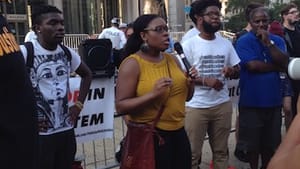Stay in the Loop
BSR publishes on a weekly schedule, with an email newsletter every Wednesday and Thursday morning. There’s no paywall, and subscribing is always free.
Battle builds over a Philly monument
The "Frank Rizzo Down" rally

The flyer I saw on Facebook read “URGENT”: there would be a rally at the Frank Rizzo statue “to oppose bigotry against Italians, law enforcement, and the ethnic fiber of Philadelphia.”
I’ve lived in East Passyunk for about a year, a few blocks away from the History of Italian Immigration Museum, the Joey Giardello statue on Passyunk, and right around the corner from Marra’s restaurant, whose delivery guys routinely block my street (with never a peep from the PPA).
Trouble is the truth
When it comes to Rizzo in 2017, things are a little confusing. There’s an earnest pro-Rizzo Facebook group called Taking Our South Philadelphia Streets Back, which planned an August 21, 2017, rally at the statue to protest calls for its removal. There’s also a satire page called Taking Back Our South Philadelphia Streets, which is trolling the former. I’m unclear about the “ethnic fiber” flyer’s origin, but the leaders of Philly for REAL Justice’s August 21 Frank Rizzo Down counter-rally posted it online as they planned their event.
What I do know is that the pro-Rizzo South Philly Facebook group’s post about Councilwoman Helen Gym’s call to remove the statue attracted a slew of invective. Commenters told Gym to “drop dead” or go back where she came from, calling her a “scumbag,” “moron,” and “crazy woman” and spewing disgusting racial slurs and memes.
Who showed up?
Gym helped bring the current nationwide rage against Confederate monuments home to Philly by reigniting calls to remove sculptor Zenos Frudakis’s 10-foot bronze statue of former Philadelphia mayor and police commissioner Frank Rizzo. The bronze Rizzo’s been waving blithely on the Municipal Services Building’s steps since 1998.
As of August 22, about 3,500 people had signed a petition to remove the statue. More than 23,800 signed a petition to keep it right where it is.
Groups like Philly for REAL Justice, Black is Back Coalition, Teacher Action Group, the Green Party of Philadelphia, and Refuse Fascism Philly are acting.
For all the online signatures defending a mayor who presided over a police force notorious for its brutal treatment of black and LGBT people (and who tried to strongarm his way into a third consecutive mayoral term on an explicit promise of white power), Rizzo’s supporters canceled their rally. Instead, the counterprotesters took center stage, drawing a diverse and passionate crowd of a few hundred people. They faced a line of police officers behind metal barricades protecting the statue that was recently spray-painted with the words “black power.” (It was also yarnbombed in 2012 with a knitted hot-pink bikini.)
It’s complicated
Monday’s rally was a reminder that even within factions, there are internal divisions. Rally organizer Philly for REAL Justice is a “police-abolitionist organization” calling for self-reliant community infrastructure and the total elimination of the police force as “a white supremacist organization that regularly executes, jails, and abuses African Americans and other communities of color.” But it expressly bans Pennsylvania Black Lives Matter leader Asa Khalif from its gatherings for his “consistent and dangerous collusion with police” and “opportunistic behavior in activist spaces.”
“Meagan,” a rally leader from Philly for REAL Justice, added that no “opportunist” liberal politician (like Gym) will co-opt the Philly people’s own liberation.
And Philly’s Italian Americans aren’t a united pro-Rizzo front.

“I don’t know where the Italians is at,” said a speaker from Black is Back. “Right here!” a supportive voice in the crowd answered.
A speaker who identified himself as the grandson of Italians who came to the U.S. in 1906 called Rizzo “a bad example of an Italian.”
Being a real Italian, he said, means “being a good neighbor and treating everyone like family” and making sure everyone has enough to eat. Rizzo didn’t qualify.
The idea that removing the Rizzo statue is “discrimination against Italians” drew deep boos from the crowd. “We’re not out here worrying about your ethnicity,” Meagan said of European-descended Philadelphians. “We’re worrying about white supremacy.”
Why stop at Rizzo?
For those at Monday night’s rally, crowding onto JFK Parkway until police shut down traffic at the peak of rush hour, the statue’s removal was the touchpoint, but the issues reach deep. These range from the Green Party’s passion for environmental justice to the ongoing scars of the first MOVE confrontation to police brutality, lack of access to healthcare, and educators’ rage at closed or underfunded schools while the police force gets plush pensions and new gear. To protestors, venerating the Rizzo statue symbolizes the white supremacist roots of it all.
“Anthony,” of Philly for REAL Justice, declared, “If you’ve decided not to fund the schools, you’ve passively said you want to put black people in prison.” And, he went on, if we’re going to root out white supremacy, why stop at Rizzo? Tear down the colonialists from Philadelphia City Hall, Mount Rushmore, and the White House while we’re at it.
“Racialized exploitation built this country,” said a social-studies teacher from the recently shuttered Germantown High School.
Meagan said it’s not whether Rizzo will come down, but how. Will the people tear it down, or will it meet a quieter administrative removal that does not address associated demands for justice on a broad spectrum?
Compared to a passionate call for a revolution in social justice, Rizzo supporters may have a lot of signatures, but in tying their pride to preserving one statue, they don’t seem to have much to say offline.
To read a related commentary by Dan Rottenberg, click here.
Sign up for our newsletter
All of the week's new articles, all in one place. Sign up for the free weekly BSR newsletters, and don't miss a conversation.
 Alaina Johns
Alaina Johns